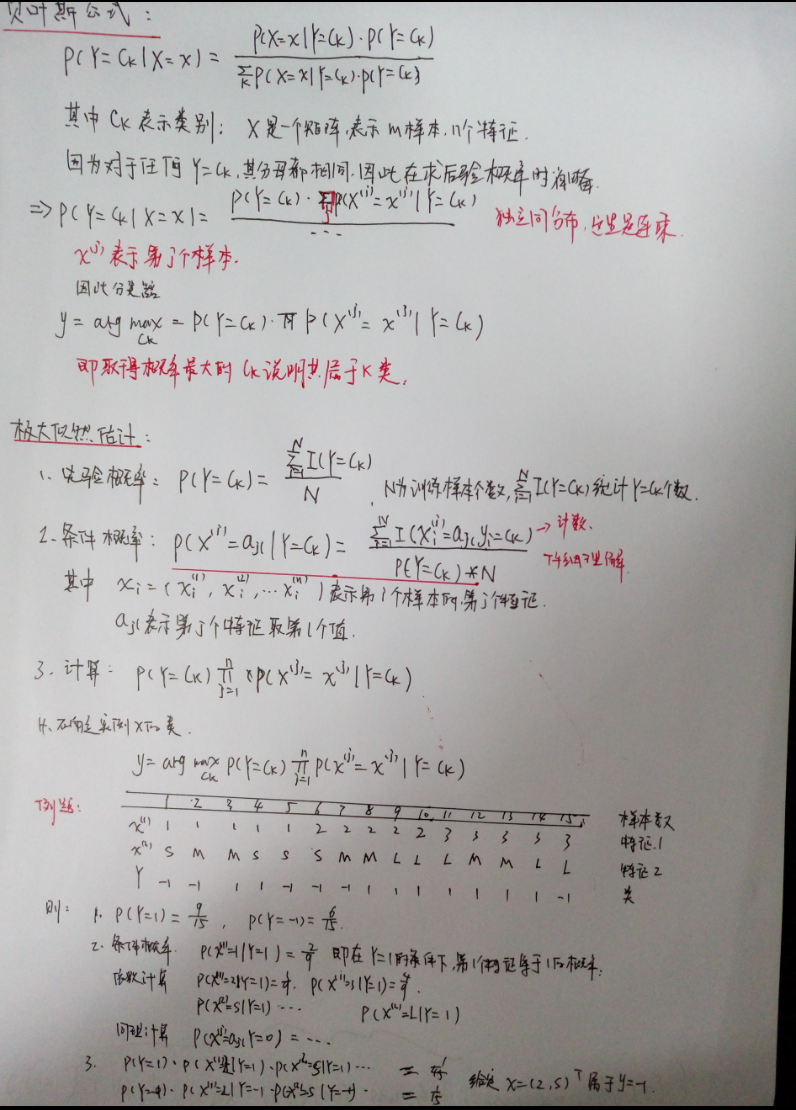基於樸素貝葉斯分類演算法實現垃圾郵箱分類
貝葉斯決策理論
在機器學習中,樸素貝葉斯是基於貝葉斯決策 的一種簡單形式,下面給出貝葉斯的基本公式,也是最重要的公式:
- 其中X是一個m*n的矩陣,m為他的樣本數,n為特徵的個數,即我們要求的是:在已知的樣本情況下的條件概率。
)表示的是條件概率
)為先驗概率
為什麼需要樸素貝葉斯
這裡有兩個原因:
- 由統計學知識,如果每個特徵需要N個樣本,那麼對於10個特徵需要
個樣本,這個資料無疑是非常大的,會隨著特徵的增大而迅速的增大。如果特徵之間獨立,那麼樣本數就可以減少到10*N,所謂的獨立及時每個特徵與其他的特徵沒有關係,當然這個假設很強,因為我們知道實際中是很難的。
- 因為獨立同分布,因此在計算條件概率的時,可以避免了求聯合概率,因此可以寫成:
下面給演算法的實現過程(打公式太難,不喜勿噴):
上述演算法的修正
1. 最後概率可能為0
在進行分類是,多個概率乘積得到類別,但是如果有一個概率為0,則最後的結果為0,因此未來避免未出現的屬性值,在估計概率時同城要進行“平滑”, 常用的是“拉普拉斯修正”(Laplacian correction),具體來說,在計算)的時候,將分子加1,分母加上類別數N.同樣在計算
)的時候在分子加1,分母加上Ni,其表示第i個屬性的可能的取值數。
2. 值過小可能會溢位
在實際中對概率取對數的形式,可以防止相乘是溢位。
垃圾郵件分類
在email/spam資料夾中有25封垃圾郵件,在email/ham中有25封正常郵件,將其進行垃圾郵件分類。
分詞
首先遇到的問題是怎樣把一封郵件進行分詞,即將其劃分成一個個單詞的形式。可以想到用正則表示式,關於正則表示式可以參考網上的資料,這裡給出python的程式,實現怎樣將一個長的字元衝進行分詞的操作。
def textParse(bigString):
import re #匯入正則表示式的庫
listOfTokens=re.split(r'\W*',bigString) #返回列表
return [tok.lower() for 示例:
#見最後的總程式
#可見它將一封郵件進行了分詞
[yqtao@localhost ml]$ python bayes.py
['peter', 'with', 'jose', 'out', 'town', 'you', 'want', 'meet', 'once', 'while', 'keep', 'things', 'going', 'and', 'some', 'interesting', 'stuff', 'let', 'know', 'eugene']這裡的re.split(r'\W*',bigString),表示以除了數字,字母和下劃線的符合進行劃分,return 的是一個列表推到式生成的列表,其中將單詞長度小於等於2的過濾掉,並且將其變成小寫字母。
生成詞彙表
將所有的郵件進行分詞後生成一個dataSet,然後生成一個詞彙表,這個詞彙表是一個集合,即每個單詞只出現一次,詞彙表是一個列表形式如:
[“cute”,”love”,help”,garbage”,”quit”…]
def createVocabList(dataSet):
vocabSet=set([])
for docment in dataSet:
vocabSet=vocabSet| set(docment) #union of tow sets
return list(vocabSet) #convet if to list 生成詞向量
每一封郵件的詞彙都存在了詞彙表中,因此可以將每一封郵件生成一個詞向量,存在幾個則為幾,不存在為0,例如:[“love”,”garbage”],則他的詞向量為
[0,1,0,1,0,…],其位置是與詞彙表所對應的,因此詞向量的維度與詞彙表相同。
#vocablist為詞彙表,inputSet為輸入的郵件
def bagOfWords2Vec(vocabList,inputSet):
returnVec=[0]*len(vocabList) #他的大小與詞向量一樣
for word in inputSet:
if word in vocabList:
returnVec[vocabList.index(word)]+=1 #查詢單詞的索引
else: print ("the word is not in my vocabulry")
return returnVec訓練演算法
這一步是演算法的核心,要計算:
1. 先驗概率
2. 計算),
) 這裡0表示正常郵件,1表示垃圾郵件。
這裡需要重點的理解是如何計算第二步的,例如,),表示在垃圾郵件的條件下第i個特徵的概率,首先先將所有的類別為1的詞向量相加,可以得到每個特徵的個數,因此在除以在類別1的單詞總數就是在垃圾郵件中每個單詞的概率了。注意,這裡所說的特徵即詞彙的每一個單詞。
python程式如下:
#這裡的trainMat是訓練樣本的詞向量,其是一個矩陣,他的每一行為一個郵件的詞向量
#trainGategory為與trainMat對應的類別,值為0,1表示正常,垃圾
def train(trainMat,trainGategory):
numTrain=len(trainMat)
numWords=len(trainMat[0]) #is vocabulry length
pAbusive=sum(trainGategory)/float(numTrain)
p0Num=ones(numWords);p1Num=ones(numWords)
p0Denom=2.0;p1Denom=2.0
for i in range(numTrain):
if trainGategory[i] == 1:
p1Num += trainMat[i] #統計類1中每個單詞的個數
p1Denom += sum(trainMat[i]) #類1的單詞總數
else:
p0Num += trainMat[i]
p0Denom +=sum(trainMat[i])
p1Vec=log(p1Num/p1Denom) #類1中每個單詞的概率
p0Vec=log(p0Num/p0Denom)
return p0Vec,p1Vec,pAbusive處理資料驗證過程
這裡首先將50封郵件讀進docList列表中,然後生成一個詞彙表包含所有的單詞,接下來使用交叉驗證,隨機的選擇10個樣本進行測試,40個樣本進行訓練。
#spam email classfy
def spamTest():
fullTest=[];docList=[];classList=[]
for i in range(1,26): #it only 25 doc in every class
wordList=textParse(open('email/spam/%d.txt' % i).read())
docList.append(wordList)
fullTest.extend(wordList)
classList.append(1)
wordList=textParse(open('email/ham/%d.txt' % i).read())
docList.append(wordList)
fullTest.extend(wordList)
classList.append(0)
vocabList=createVocabList(docList) # create vocabulry
trainSet=range(50);testSet=[]
#choose 10 sample to test ,it index of trainMat
for i in range(10):
randIndex=int(random.uniform(0,len(trainSet)))#num in 0-49
testSet.append(trainSet[randIndex])
del(trainSet[randIndex])
trainMat=[];trainClass=[]
for docIndex in trainSet:
trainMat.append(bagOfWords2Vec(vocabList,docList[docIndex]))
trainClass.append(classList[docIndex])
p0,p1,pSpam=train(array(trainMat),array(trainClass))
errCount=0
for docIndex in testSet:
wordVec=bagOfWords2Vec(vocabList,docList[docIndex])
if classfy(array(wordVec),p0,p1,pSpam) != classList[docIndex]:
errCount +=1
print ("classfication error"), docList[docIndex]
print ("the error rate is ") , float(errCount)/len(testSet)完整的程式碼如下:
from numpy import *
#create a vocablist of set ,word can only exit once
def createVocabList(dataSet):
vocabSet=set([])
for docment in dataSet:
vocabSet=vocabSet| set(docment) #union of tow sets
return list(vocabSet) #convet if to list
def bagOfWords2Vec(vocabList,inputSet):
returnVec=[0]*len(vocabList)
for word in inputSet:
if word in vocabList:
returnVec[vocabList.index(word)]+=1
else: print ("the word is not in my vocabulry")
return returnVec
# tranin algorithm
# the p1Num is mean claclualte in 1 class evrey word contain weight
def train(trainMat,trainGategory):
numTrain=len(trainMat)
numWords=len(trainMat[0]) #is vocabulry length
pAbusive=sum(trainGategory)/float(numTrain)
p0Num=ones(numWords);p1Num=ones(numWords)
p0Denom=2.0;p1Denom=2.0
for i in range(numTrain):
if trainGategory[i] == 1:
p1Num += trainMat[i]
p1Denom += sum(trainMat[i])
else:
p0Num += trainMat[i]
p0Denom +=sum(trainMat[i])
p1Vec=log(p1Num/p1Denom)
p0Vec=log(p0Num/p0Denom)
return p0Vec,p1Vec,pAbusive
# classfy funtion
def classfy(vec2classfy,p0Vec,p1Vec,pClass1):
p1=sum(vec2classfy*p1Vec)+log(pClass1)
p0=sum(vec2classfy*p0Vec)+log(1-pClass1)
if p1 > p0:
return 1;
else:
return 0
# split the big string
def textParse(bigString):
import re
listOfTokens=re.split(r'\W*',bigString)
return [tok.lower() for tok in listOfTokens if len(tok)>2]
#spam email classfy
def spamTest():
fullTest=[];docList=[];classList=[]
for i in range(1,26): #it only 25 doc in every class
wordList=textParse(open('email/spam/%d.txt' % i).read())
docList.append(wordList)
fullTest.extend(wordList)
classList.append(1)
wordList=textParse(open('email/ham/%d.txt' % i).read())
docList.append(wordList)
fullTest.extend(wordList)
classList.append(0)
vocabList=createVocabList(docList) # create vocabulry
trainSet=range(50);testSet=[]
#choose 10 sample to test ,it index of trainMat
for i in range(10):
randIndex=int(random.uniform(0,len(trainSet)))#num in 0-49
testSet.append(trainSet[randIndex])
del(trainSet[randIndex])
trainMat=[];trainClass=[]
for docIndex in trainSet:
trainMat.append(bagOfWords2Vec(vocabList,docList[docIndex]))
trainClass.append(classList[docIndex])
p0,p1,pSpam=train(array(trainMat),array(trainClass))
errCount=0
for docIndex in testSet:
wordVec=bagOfWords2Vec(vocabList,docList[docIndex])
if classfy(array(wordVec),p0,p1,pSpam) != classList[docIndex]:
errCount +=1
print ("classfication error"), docList[docIndex]
print ("the error rate is ") , float(errCount)/len(testSet)
if __name__ == '__main__':
#下面的為了演示分詞的,可註釋
#listWord=textParse(open('email/ham/1.txt').read())
spamTest()執行與測試:直接python bayes.py執行,結果如下:
[yqtao@localhost ml]$ python bayes.py
classfication error ['home', 'based', 'business', 'opportunity', 'knocking', 'your', 'door', 'don', 'rude', 'and', 'let', 'this', 'chance', 'you', 'can', 'earn', 'great', 'income', 'and', 'find', 'your', 'financial', 'life', 'transformed', 'learn', 'more', 'here', 'your', 'success', 'work', 'from', 'home', 'finder', 'experts']
[yqtao@localhost ml]$ python bayes.py
the error rate is 0.0
[yqtao@localhost ml]$ python bayes.py
the error rate is 0.0
[yqtao@localhost ml]$ python bayes.py
the error rate is 0.0
[yqtao@localhost ml]$ python bayes.py
classfication error ['scifinance', 'now', 'automatically', 'generates', 'gpu', 'enabled', 'pricing', 'risk', 'model', 'source', 'code', 'that', 'runs', '300x', 'faster', 'than', 'serial', 'code', 'using', 'new', 'nvidia', 'fermi', 'class', 'tesla', 'series', 'gpu', 'scifinance', 'derivatives', 'pricing', 'and', 'risk', 'model', 'development', 'tool', 'that', 'automatically', 'generates', 'and', 'gpu', 'enabled', 'source', 'code', 'from', 'concise', 'high', 'level', 'model', 'specifications', 'parallel', 'computing', 'cuda', 'programming', 'expertise', 'required', 'scifinance', 'automatic', 'gpu', 'enabled', 'monte', 'carlo', 'pricing', 'model', 'source', 'code', 'generation', 'capabilities', 'have', 'been', 'significantly', 'extended', 'the', 'latest', 'release', 'this', 'includes']
the error rate is 0.1因為是隨機選擇的樣本,可以執行10次取平均值,可以觀察到,測試效果還不錯。還有一點要注意,這裡一直出現的是將垃圾郵件誤判為正常郵件,這會比將正常的誤判為垃圾郵件要好。
參考資料:
- 《統計學習方法》李航著
- 《機器學習》周志華著
- 《機器學習實戰》Peter Harrington


